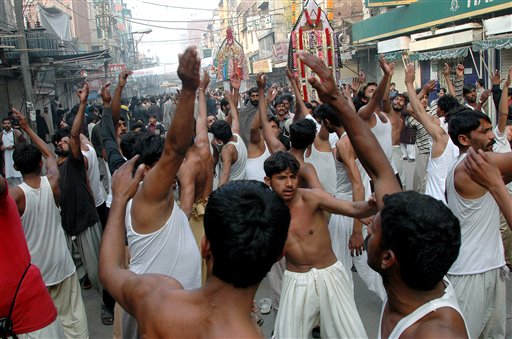
QUEENS–Muhammad Raza’s right hand hovers high in the air above his head for just a moment, just one beat of the a cappella chorus reverberating in the hall around him. Then riding the down beat, the hand slams across his bare chest, onto his left pectoral muscle, where the skin is red and purple from the blows that have come before.
His left hand rises high on the third beat. It, too, hovers for half a moment then crashes into the opposite side of his chest, where the bruises mirror the others.
The hall is filled with hundreds of men swaying to the rhythm. Their baritone voices intone mournful melodies, their hands rising and falling in unison. Brows are moist and the air is thick with exertion.
As the melody crescendos, the hall pulses with the deep, percussive sound of their strikes. This sound will ring out nightly during the first ten days of the Islamic month of Muharram. For Shi’a, it is the most holy time of year, marked with their most distinctive of rituals.
The men have gathered at the Imam Al-Khoei Islamic Center at 89-89 Van Wyck Expressway in Queens at this time to commemorate the martyrdom of one of the founders of their faith, Imam Hussein. Each blow is a reminder of the suffering endured by Hussein and those who died with him.
The distinction between Islam’s two largest sects often eludes non-Muslim observers. Religiously, the variances can seem minor – the position of the hands during prayer, emphasis of certain texts over others, veneration of a particular leader. But at no time is the difference between the two groups as palpable, or as volatile, as during Muharram.
For all Muslims, the first of Muharram marks the beginning of a new Islamic year, often celebrated with the exchange of cards or gifts. But for Raza and the other Shi’a who have gathered at the Imam Al-Khoei Islamic Center, this time of year has special significance.
In the Islamic civil wars that erupted following the death of Mohammed in 623 A.D., a pivotal battle took place at the city of Karbala in present-day Iraq. The tenth of Muharram, which falls on a different day in the Western calendar each year, is the anniversary of the final day of this battle in which Imam Hussein, the grandson of the Prophet Mohammad, was killed by his enemies.
For the minority of Muslims who are Shi’as, Hussein was Imam, the leader of faith, and the rightful successor to the Prophet, appointed by God. His martyrdom on the battlefield of Karbala solidified the schism between Sunni and Shi’a.
During the first 10 days of Muharram, according to officials at the Al-Khoei Center, between 3,000 and 4,000 Shi’as gather nightly. On the sixth day, prayers began at 8 p.m., followed by a majlis, or gathering.
Worshipers separated into language groups and gathered in one of the many large halls within the fortress-like, three-story complex that dominates the intersection of 90th Avenue and the Van Wyck Expressway.
At each of these gatherings, the story of Hussein’s killing was recounted in one of the languages spoken by New York’s Shi’a immigrant community – Urdu, Farsi, Arabic or English. In each tongue, the tale was retold in precise, vivid detail, with the speakers wailing and weeping at the climax of the account.
The Urdu majlis, easily the largest of all, took place in the main hall where men and women sat separated by a 7-foot opaque barrier. At the conclusion of the story in the main hall, a succession of informal groups of men took the stage to lead songs of commemoration in Urdu or Punjabi, while a replica of Hussein’s coffin was carried about the room.
The men kept time by striking their chests, their sound and smell wafting over the barrier to the women’s side of the hall. The action is done to express grief over Hussein's death and to share in his suffering.
Some perform the ritual symbolically, with little actual force. But for many, the suffering becomes real as they strip to undershirts or bare skin. Shi’as have been known to draw blood during such commemorations.
When Raza, the 21-year old son of Pakistani immigrants, pulled his baggy sweatshirt back over his discolored torso, he could have been any other college-aged New Yorker on the subway, sweaty from a game of pick-up basketball.
“For me, it’s very personal,” he said. “I cherish this month.”
In reliving the events of Karbala, Shi’as reconnect with the birth of their religious identity. In the unvarnished demonstration of their grief, the participants reaffirm and galvanize their relatively small corner of the Muslim world.
“The Sunnis’ [celebration] is markedly different,” said Syed Razvi, the official representative of the Al-Khoei Center to the United Nations. “We do it with a lot of passion.”
Shah Sayed, 55, expressed the meaning of the holiday more simply. Beneath a short-brimmed black knit cap, he set his proud, lined face somewhere between a smile and a frown and gestured to the hall around him.
“This,” he said with a wide sweep of his arm, “is Shi’a.”
This Glimpse of Faith was filed by News21 Fellow Brett Elliott

 Print
Print Bookmark
Bookmark
